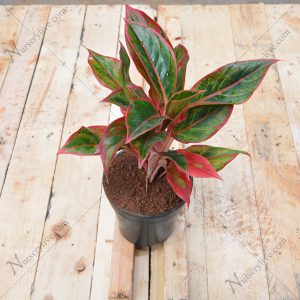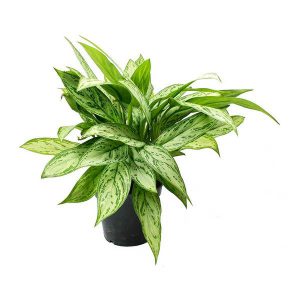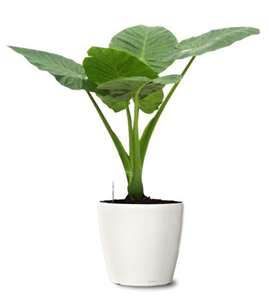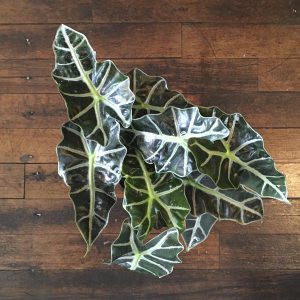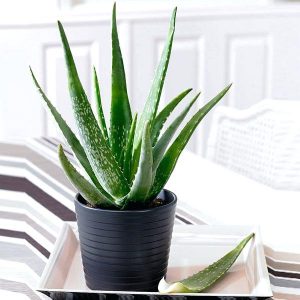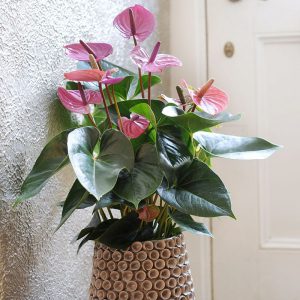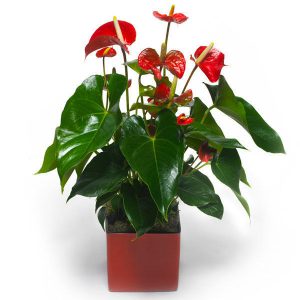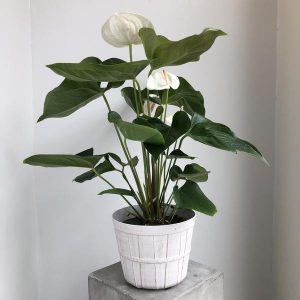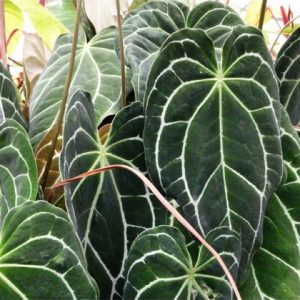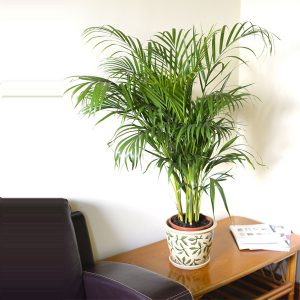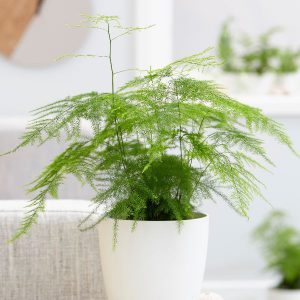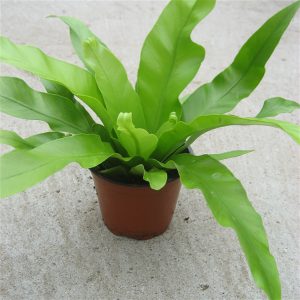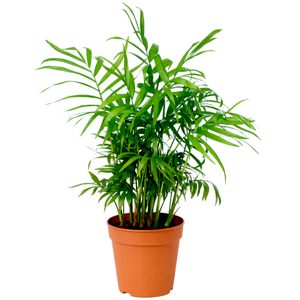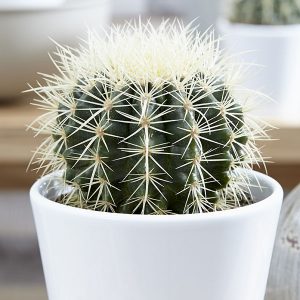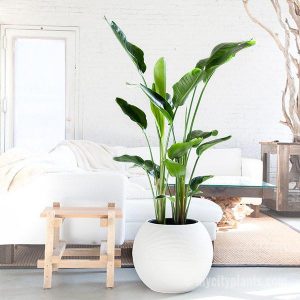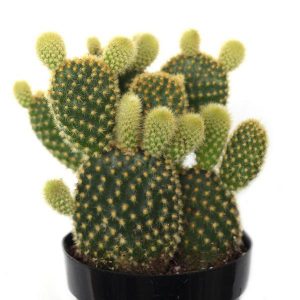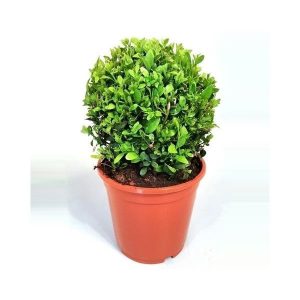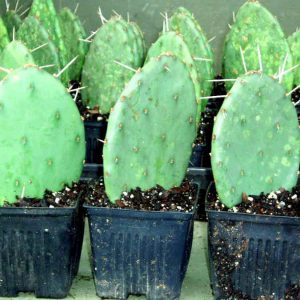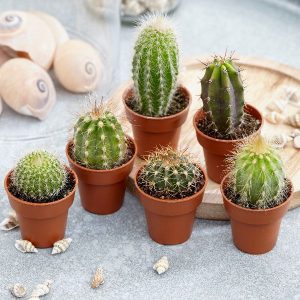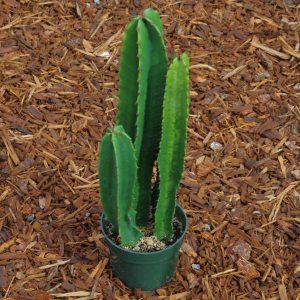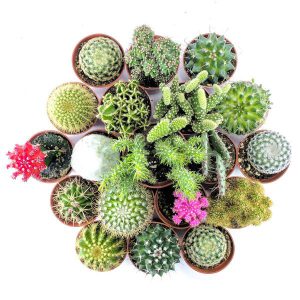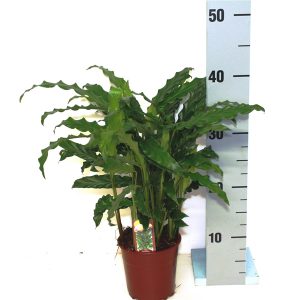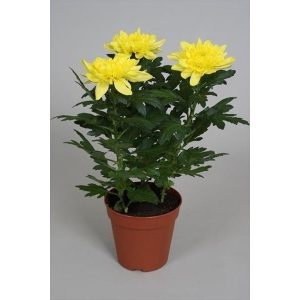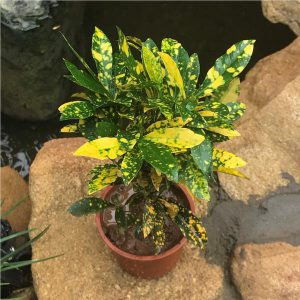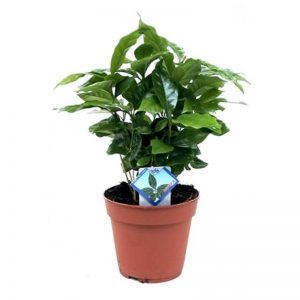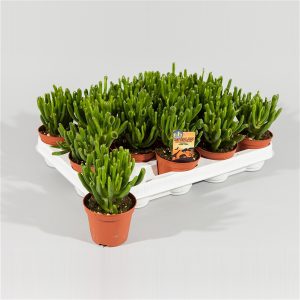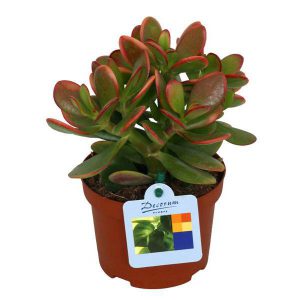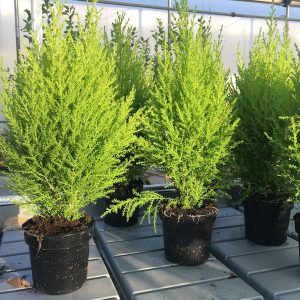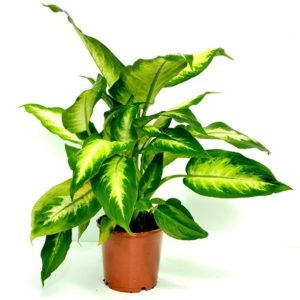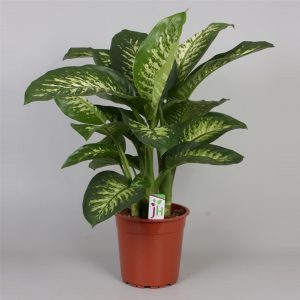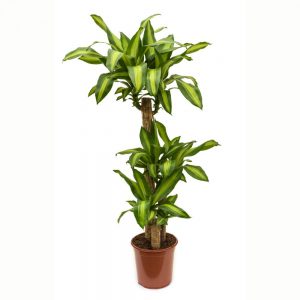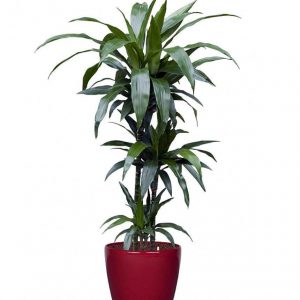Indoor Plants
Agave blue glow
Agave is not a difficult plant to grow. They’re slow-growing and dramatic and will even thrive on a bit of neglect. If you’re the type of person who likes to fuss with houseplants and water a lot, Agave is probably not the plant for you. If, however, you’re the type of person who likes to set it and forget it, and you have a sunny window, Agave might the way to go. Be aware that some of the large varieties will eventually outgrow your room (unless you have a large greenhouse), and Agave can be aggressive. They have irritating sap and sometimes very sharp thorns that can cause injuries to small children and even pets.
In general, Agave do not need to be repotted every year. Most of the species commonly found in cultivation grow very slowly and will take a long time to outgrow their pot. It’s also best to handle your Agave as little as possible, since they do not like to be disturbed. When you do repot, refresh the spent soil with new potting mix and make sure the plant is firmly anchored in its pot
AED 0.00Read more
Aglaonema red
Light: The darker green varieties of aglaonema can grow in near shade, while the variegated varieties require brighter light. Do not expose any aglaonema to Direct Sun
Water: Water thoroughly in the summer and mist the plant often to raise the humidity. During the winter, reduce watering but do not let the plant dry out completely.
Temperature: These plants do not like cold drafts or temperatures below 65 F. Be sure to keep them away from drafty windows or vents and the warmer the spot you can find for them, the better.
AED 55.00Add to cart
Aglaonema silver queen
WATERING Aglaonema Silver Queen – If you place your Aglaonema Silver Queen in high light, you can allow the potting mix to dry down approximately 1/2 to 3/4 of the way before watering thoroughly. In a lower light situation, allow soil to dry between waterings.
TEMPERATURES for Aglaonema Silver Queen should be at a minimum of 60°F. It is easily damaged by cold drafts and temperatures. Be sure to keep away from cold spots and drafts and move away from cold window panes in the winter time.
PLACE Aglaonema Silver Queen in any shaded location. Full sun, especially through glass, will most likely burn the exposed leaves. This plant will survive in low light For a really nice looking plant, try to provide
AED 55.00Add to cart
Alocasia california
Alocasia california. Alocasia. An Alocasia plant, native to Asia, is also called an Elephant Ear plant or African Mask plant because of their very large, glossy, heart-shaped leaves with wavy edges. These stunning, veined leaves come in red, bronze, blue-green, and purple.
AED 370.00Add to cart
Alocasia Polly Elephant Ear Plant
An Alocasia plant requires very bright indirect light but no direct sun.
Allow the top 2″- 3″ of soil to dry out before watering, and try to keep the soil evenly moist. Over-watering, wet leaves, and soggy soil makes an Alocasia plant susceptible to a variety of serious fungal infections. Check the soil frequently until you are sure of the plant’s watering needs. Alocasia plants require less water during the winter when it’s dormant.
Alocasia plants prefer warm temperatures between 60°-80.° These plants becomes dormant with prolonged exposure to temperatures below 60° and may drop all of their leaves. Be sure to keep an Alocasia plant away from air conditioners and cold drafts. During warm summer months, an Alocasia can produce a new leaf every week and each new leaf may be twice the size of the previous leaf.
AED 70.00Add to cart
Aloe vera Barbadensis Mille
As much as the Aloe Vera is used to hot and dry fields and often does not require water for a period of several months, regular watering is recommended. In dry periods, the Aloe Vera draws its moisture from the fleshy leaves. However, this inhibits its healthy and splendid growth. To prevent this, this Aloe species should always have a moist root ball during spring to late summer. You can test with your thumb, whether the plant needs water. If the surface can be pressed down a little bit, the soil is still moist inside. If the surface does not drop at least two to three centimeters under your thumb pressure, it should be watered
AED 45.00Add to cart
Anthurium Pink
Anthurium is a popular guest and not just in your home. The plant is loved by its shiny green leaves are colored bracts and cheerful flask. Thus you give your interior an instant red, pink, purple, orange, yellow, white or green boost. Try Just try not to be cheerful
AED 65.00Add to cart
Anthurium Red
Anthurium is a popular guest and not just in your home. The plant is loved by its shiny green leaves are colored bracts and cheerful flask. Thus you give your interior an instant red, pink, purple, orange, yellow, white or green boost. Try Just try not to be cheerful
AED 65.00Add to cart
Anthurium White
Anthurium is a popular guest and not just in your home. The plant is loved by its shiny green leaves are colored bracts and cheerful flask. Thus you give your interior an instant red, pink, purple, orange, yellow, white or green boost. Try Just try not to be cheerful
AED 65.00Add to cart
Anthurium-Crysatallinum
To thrive in our homes, anthuriums need medium to bright indirect light, although they’ll accept less during their dormant period in winter. They are sensitive to direct light and burn easily, so take care to protect from hot afternoon sunbeams.
Proper watering is key to Anthurium care (and to the care of all your houseplants!). Keep the soil lightly moist during the growing season (March-September), letting the top layer just approach dryness between waterings. Make a habit of checking on it at least once or twice a week by gently digging a finger into the soil. It should feel barely moist. If it still feels wet, wait a bit longer.
Proper Anthurium care means keeping a watchful eye in winter and protecting your plants from drafty doors and windows. They will suffer or even die below 55 degrees and are happiest between 65-70. It’s also important to protect your Anthurium from forced air. Heaters, fans, and air conditioners can damage plants if they are too close, but gentle air circulation (such as an open window on a warm, humid day) will benefit them.
AED 90.00Read more
Arecca palm
Areca palm (Chrysalidocarpus lutescens) is one of the most widely used palms for bright interiors. It features feathery, arching fronds, each with up to 100 leaflets. These big, bold plants command attention.
1. During the spring and summer the soil must be kept moist. In fall and winter, however, the soil should get a bit dry between watering.
2. The sunlight should be either bright indirect or curtain filtered.
3. Temperature fluctuations may be dangerous. In the winter months try to keep temperatures from 60-70 F at night and the day temperatures should be from 75-85 F.
4. From spring to fall use a fertilizer to give the soil all the necessary nutrients for a year.
AED 35.00Add to cart
asparagus fern
Asparagus aethiopicus, Sprenger’s asparagus, is a plant native to the Cape Provinces and the Northern Provinces of South Africa. Often used as an ornamental plant, it is considered an invasive weed in many locations
AED 40.00Add to cart
asparagus setaceus
Asparagus setaceus, commonly known as common asparagus fern, lace fern, climbing asparagus, or ferny asparagus, is a climbing plant in the genus Asparagus. Despite its common name, the plant is not a true fern, but has leaves that resemble one
The fern may dry out to the point it appears dead; however, outdoor springtime temperatures generally revive them. Keep the plant well watered in all situations and repot every few years. Care ofasparagus ferns indoors involves misting the arching stems to provide humidity to the plant.
AED 28.00Add to cart
asplenium antiquum
Asplenium nidus comes from eastern tropical Africa, northern Australia, and tropical Asia. While it can be either epiphytic or terrestrial, it’s fond of rich organic matter. It often can be found living in bromeliads or on palm trees in its natural environment. It’s also wildly popular as a houseplant, with light to medium green leaves that are reminiscent of banana leaves in appearance.
AED 95.00Add to cart
Bamboo (chamadorea elegans)
Although a bamboo palm grows faster in bright indirect light, it still does well in medium light and even low light if you’re careful not to over-water.
Allow the top 1/3 of the soil of a bamboo palm to dry out before watering. These plants like barely moist but never soggy soil. Never allow a bamboo palm to sit in the excess water that drains from the pot. Do not use water that has passed through a softener because the high salt content damages the leaves. Leaf tips look pale in color and green leaves fall off an over-watered bamboo palm. New growth and leaf tips turn brown when a bamboo palm is under-watered. The confusing thing is that yellow leaves can develop when the plant is over or under- watered, so you need to check the soil as far down as you can to know if the plant needs water.
AED 30.00Add to cart
Barrel cactus
Echinocactus grusonii, popularly known as the golden barrel cactus, golden ball or mother-in-law’s cushion, is a well known species of cactus, and is endemic to east-central Mexico.
Water is a very important component to caring for barrel cactus. The plants are native to arid desert regions and usually have only rainfall to supply their moisture needs. Water your barrel cactus once per week in summer. The barrel cactus doesn’t need much water in winter when it is dormant.
AED 200.00Add to cart
Bird of paradise
Since birds of paradise are tropical plants, it’s no surprise that they enjoy bright sunlight. Place your indoor bird of paradise in a spot where it will get the most light. The only exception is if it’s very hot, such as in a sun room; in that case, bright, indirect light is best. If your plant’s leaves are yellowing, try increasing the amount of light exposure.
Birds of paradise prefer rich, well-draining soil that still retains some moisture.
Birds of paradise do best with a regular watering schedule. Keep the soil moist in spring and summer, during the growing season, but allow the soil to dry between waterings in the dormant fall and winter months.
Water that has a high salt content could burn the leaves. If this is the case with your water, consider using rain water, when possible, or distilled water to water your bird of paradise. Birds of paradise do well in typical household humidity, but they may benefit from intermittent misting during dryer winter months.
AED 50.00Read more
Bunny ear cactus collection
Cacti are the perfect plant for the novice gardener. They are also the perfect specimen for a neglectful gardener. Bunny ears cactus plant, also called angel’s wings, has ease of care combined with an original appearance.
AED 100.00Add to cart
Buxus sempervirens
This widely used genus is prized for its evergreen foliage and its ability to withstand heavy pruning. The yellow-green flowers are insignificant. Buxus has been used in hedging, topiaries, and parterres for centuries.
Noteworthy CharacteristicsOpposite, glossy rounded to lance-shaped leathery leaves. Variegated forms exist.
CareGrow in any soil, preferably in part shade. Tolerates full sun if the soil is moist. Prune in late spring and summer; supply fertilizer after any heavy pruning to aid in regeneration.
PropagationRoot semi-ripe cutttings in summer. Graft in winter.
AED 370.00Add to cart
cactus ears
This classic cactus has large, flat, dusty green paddles with lots of sharp thorns. The thorns are evenly distributed across the pads and also form an areola at the tip of each pad.
In addition to stationary thorns, the prickly pear also produces loose thorns called “glochids”. These thorns are barbed and can fasten onto skin and clothing.
With all of these thorns, it’s a bit hard to understand why the Opuntia is such a popular ornamental cactus until you see the blossoms, which grow from the areola of thorns.
AED 60.00Add to cart
cactus collections
As the plants in the garden are waning, this is a perfect time to start looking for indoor opportunities to nurture a green thumb, and cactus collections are a great way to play with plants while reducing (as much as possible) the risk that you will kill something. Cacti come in all shapes and sizes and offer collectors the opportunity to play with color and shape in much the same way that an art collector might curate a collection of sculpture.
AED 200.00Add to cart
Cactus Ingens
A potted cactus will live and flower in the house if given enough light, place the plant near a bright lighted window, where it will receive light most of the day. On the patio is different place the cactus in a partly shaded area until it become accustom to the sun. Never bring the cactus home and place it in the bright sun, cactus sun burn just like people
AED 105.00Read more
Cactus Mini
As the plants in the garden are waning, this is a perfect time to start looking for indoor opportunities to nurture a green thumb, and cactus collections are a great way to play with plants while reducing (as much as possible) the risk that you will kill something. Cacti come in all shapes and sizes and offer collectors the opportunity to play with color and shape in much the same way that an art collector might curate a collection of sculpture.
AED 125.00Add to cart
Calathea Blue Grass
Grow your calathea plants indoors at temperatures between 60 and 70 degrees F. If your indoor temperatures are warmer than this, provide them with extra humidity. Keep calathea plants away from drafts.
Increase the humidity in the room where you are growing calathea plants. Situate them on pebble-filled saucers. Fill the saucers up with water to just below the level of the top of the rocks. The evaporating water will increase humidity in the area around the plant. Another way to increase humidity is to run a humidifierin the room.
Water with room-temperature water when the soil is dry one to two inches below the surface. Don’t allow the soil to dry out completely. It should still be moist in the center of the root ball when you water it. Zebra plants hate wet feet–don’t let them sit in standing water. Water less in winter; the soil will dry out more slowly and won’t need as frequent watering as during active growth in summer.
AED 55.00Add to cart
Chrysanthemum Indicum
Chrysanthemum indicum is a flowering plant commonly called Indian chrysanthemum, within the family Asteraceae and genus Chrysanthemum.
AED 35.00Add to cart
Codiaeum Variegated Gold dust
Like most houseplants, they also appreciate abundant humidity. You can boost humidity for your croton by growing it in a well-lit kitchen or bathroom, placing a small humidifier nearby, or grouping it nearby other houseplants.
Fertilize croton in spring and summer to keep it healthy and growing. Crotons only need fertilizer once or twice during the season, but you can get them to grow faster by fertilizing more frequently. Follow the directions on the fertilizer package whenever feeding your plants.
AED 95.00Add to cart
Coffee Arabica Plant
Coffea arabica (/əˈræbɪkə/), also known as the Arabian coffee, “coffee shrub of Arabia”, “mountain coffee” or “arabica coffee”, is a species of Coffea. It is believed to be the first species of coffee to be cultivated, and is the dominant cultivar, representing about 60% of global production.[1] Coffee produced from the (less acidic, more bitter, and more highly caffeinated) robusta bean (C. canephora) makes up most of the remaining coffee production. Arabica coffee was first found in Yemen and documented by the 12th century.[2] Coffea arabica is called būna in Arabic.
AED 55.00Add to cart
Crassula Horn
Crassula ovata, commonly known as jade plant, friendship tree, lucky plant, money plant or money tree, is a succulent plant with small pink or white flowers. It is native to South Africa and Mozambique, and is common as a houseplant worldwide. Much of its popularity stems from the low levels of care needed; the jade plant requires little water and can survive in most indoor conditions. It is sometimes referred to as the money tree; however
AED 35.00Add to cart
Crassula Sunset
Jade plant is also considered a lucky symbol/sign for money. Its other names are “Money Plant,” ” Dollar Plant,” “Lucky Plant,” and “Friendship Plant.
AED 40.00Add to cart
Cupressus
Evergreen lime-green foliage stands out wonderfully as a centrepiece of a flower bed, in a patio container, or even grown as a low hedge. Cupressus ‘Goldcrest’ is a truly versatile plant and will certainly earn its place in any scheme.
Plant out cypress an any well drained soil in full sun and provide shelter from strong, drying winds. If container grown, use a good quality soil based compost .
AED 65.00Add to cart
Diffenbachia Camila
Dieffenbachia is one of the easiest indoor houseplants to grow — and one of the most common indoor plants. This tropical shrub shows off lush leaves that are usually marked in shades of cream, yellow, or white, making dieffenbachia a top pick for brightening dim corners indoors. Dieffenbachia adds fun color and texture without flowers.
- Light. Most dumb cane plants prefer a medium to bright light source. …
- Water. The best way to water your dumbcane is to let it get moderately dry and then completely drench the soil. …
- Soil. Like many houseplants, dieffenbachia plants need a soil that retain some water but also drain well. …
- Fertilizer.
AED 30.00Add to cart
Diffenbachia Tropic snow
Plant care
Light: Bright but filtered or diffused sunlight is sufficient to ensure healthy growth of this plant (near bright east or south window).
Water: Water regularly and thoroughly because infrequent watering can cause leaves of your dieffenbachia to become brown and unattractive.
Water, then allow the soil to drain and empty excess water. This is necessary to prevent root rot.
A well-draining potting mixture should be used. Let the soil dry out to about an inch down before you water again. Drooping yellow leaves may be a sign of overwatering.
Temperature: The ideal temperature range for growing a Tropic Snow Dumb Cane is 70 to 80 degree.
Fahrenheit during the day, and 60 to 65 degree at night. Plant can tolerate 50 degrees Fahrenheit without damage but avoid cold drafts. If plants becomes too cold, the leaves will turn yellow and droop.
AED 145.00Add to cart
Dracaena Compacta
A Dracaena compacta plant grows best in medium light. In low light area they grow very slowly or not at all, tend to lose bottom leaves, and are easily over-watered. Rotate dracaenas weekly so that they don’t grow toward the light, become one sided, and lose their beautiful shape..
Like other indoor houseplants, a Dracaena compacta uses less water in low light than in brighter light. Keep the plant on the dry side to prevent root rot and Leaf Spot Disease. Allow the top ¾ of the soil to dry out before watering. In low light this could be two weeks or more. Compacta plants do better when watered on a regular schedule. Brown tips usually indicate too much too much chlorine or fluorine in the water. Muddy brown leaf tips on new growth means the plant needs more water.
Dracaena Compacta plants like warm room temperatures (60-75°F/16-24°C). Cold winter drafts and heaters can damage the leaves.
AED 210.00Add to cart
Dracaena Fragrans Massangana
The Dracaena fragrans ‘Massangeana’ plant, also known as the corn plant, is made up of shiny green leaves that have a yellow streak running down the center of the leaves. Most Dracaena fragrans ‘Massangeana’ are grown indoors in pots and are relatively low-maintenance plants. These tropical plants don’t handle cold temperatures well.
AED 90.00Add to cart
Dracaena Janet craig
Name: Dracaena deremensis ‘Janet Craig’
Janet Craig is one of the most popular Draceanas used indoors, likely due to it’s ability to grow in low light and tolerate considerable dryness.
It is a medium sized Draceana, usually planted with 3 to 5 stalks per pot. It’s leaves are dark green, approximately 2 feet in length and about 3 inches wide, and cascade downward gently from the stalk.
The “Compacta” variety is, like its name suggests, is a compact smaller version, growing about only 1 foot tall with small leaves tight to the stalk.
The temperature requirements for Janet Craig is a comfortable 75 degrees and the water requirements are low. Dracaenas are one of the plants used in the NASA Clean Air Study and has shown to help remove Formaldehyde.
The wide leaves on Dracaenas can and do accumulate dust. Wipe leaves down regularly with a damp cloth to remove dust. Although most Dracaenas have few problems with pest, occasionally mealy bug and scale can attack the plant.
If you’re ready to discover the inside scope on Dracaena care check out this special Dracaena care guide. Grab this special care guide on Dracaeas today.
AED 210.00Add to cart
Dracaena Marginata
Dracaena marginata plants can be used as table plants but they are especially impressive as tall trees with multiple canes and hundreds of long thin green leaves trimmed in dark red.
AED 110.00Add to cart
Dracaena Reflexa- Song of India
Temperature: The ideal temperatures are between 60°F (15°C) – 80°F (27°C). Allowing temperatures to go below 55°F/12°C can harm the plant. Avoid having a plant sitting near cold drafts.
Light:A brightly lit spot without direct sunshine is suggested. A small amount of morning or evening sun is not a problem.
Watering: would try and keep the soil slightly moist at all times and in the winter allow the soil to dry. You should be able to leave a dracaena reflexa for up to a month during winter without water and no harm would be caused. Over-watering can kill these.
AED 1,235.00Add to cart
Dracaena Rikki
water the plant deeply and then allow the soil to drain thoroughly. Allow the top 2 inches of potting mixture to dry before the next watering. Dracaena “Rikki” benefits from a monthly feeding during spring and summer, using a standard liquid fertilizer for indoor plants. No fertilizer is advised during fall and winter
AED 210.00Add to cart
Dracaena White stripe
A house plant which has wonderful foliage. Dracaena ‘White Stripe’ (Dracaena fragrans) is a sensational variety with very distinctive dark green leaves streaked with white.
- The sharp contrasting stripes make this an attractive plant for the home.
- Stand your Dracaena in a light spot out of direct sunlight.
- Dracaena are wonderful house plants that originate from Africa and southern Asia. The name comes from the Ancient Greek meaning ‘female dragon’.
- These easy-to-care-for house plants are long living and they also purify the air, meaning they are good for your health!
- These have thick, robust stems.
- Easy to care for.
- Do not allow to stand too long in water. Water regularly but allow to partially dry out before watering again.
- Protect from frost.
- You will receive 3 plants in one pot with varied stem heights 90, 60 and 30 cm.
- Delivery height 130-150 cm,
AED 210.00Add to cart


